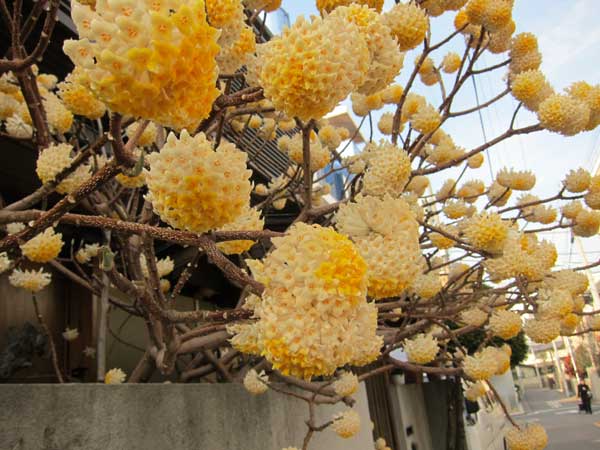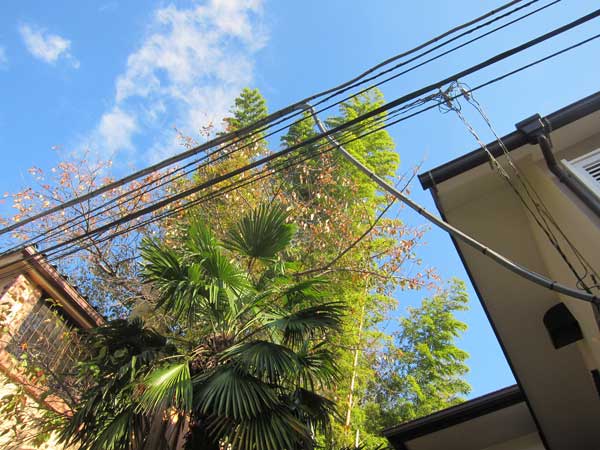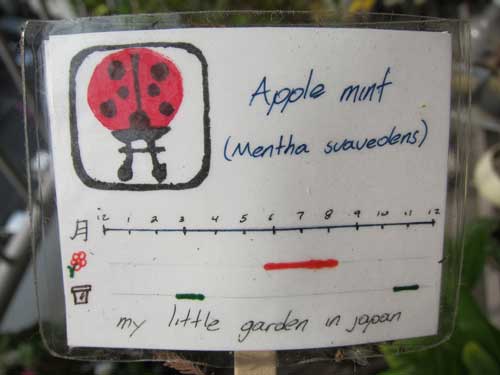
Called keyaki in Japanese, these elegant trees give distinction to Tokyo’s global brand shopping street. These trees are gorgeous year-round, but especially in fall.

The rooftop garden of the new Tokyu Plaza Omotesando Harajuku mall, the one with the fun house, crazy mirror escalator entrance, it is much more lively than I expected. On a nice day, it draws a large crowd to relax and chat in the shade. I am impressed with the generously tall size of the trees, the irregular openings of the deck for plantings, and the many levels that provide seating and variation. The roof garden is partly visible from the sidewalk, unlike the older department store roof gardens, and forms part of the architecture of the building. Perhaps that’s why it’s more discoverable and popular.

なぜは庭なしの新しい自宅が人気なのでしょうか。表参道では、バブル前と80時代後の自宅の差が大きいです。
Walking in Omotesando, you can see the contrast between houses built before and after the 1980s. Unfortunately, most of the new houses occupy the entire lot, with no room for the sizable gardens in their pre-Bubble predecessors.

表参道 で、ミツマタという木をはじめて見ました。裸の枝に、香り高い花がたくさん咲いていました。木の持ち主が説明してくれました。五百年前に中国から輸入されて、ミツマタは、和紙を作るために使用されます。
I was admiring this fragrant tree with poofy balls of yellow and white flowers on bare branches. It’s in a shallow residential garden near Omotesando Koffee. Luckily, the owner came by as I was photographing, and explained that it’s called mitsumata, because of its three branch structure.
Later, I learned it’s called paperbush in English, and it’s known for producing high quality paper, once used for Japanese bank notes. The Kew Botanic Garden website says that it originates in China and has been cultivated in Japan and Korea since the 16th century. It’s also used in Chinese medicine.
In the photo below, you can see how the newer residential styles, with sleek concrete facades, close the house from the street, and very often include no plants at all. A sad contrast for garden lovers.


この素敵な盆栽はOmotesando Koffeeのオーナが作った作品です。コケが特に元気そうです。表参道に来た時はいつもこの美味しいコーヒーを飲んで、昭和モダンふうのインテリアと庭を楽しみながら、バリスタと話して行きます。
This beautiful bonsai was decorating the very chic Omotesando Koffee shop. The cafe is a modern cube inside a Showa house with a cozy front garden. The very cheerful barista explained that the owner made this bonsai himself. I like how the bonsai looks next to the cappuccino and the aged wood of the house and cupboard. The moss is especially lush and lovely.

建物の間の狭いところが私をひきつけます。密集した都市のこんなスペ—スは、とても楽しいと思います。狭いのに、十五メートルの高さの竹と冬に葉を落としている木とシュロというヤシが元気そうです。
I was captivated by this narrow green space between residences in Omotesando. The places between spaces have a tremendous appeal in dense Tokyo. This tiny space supports 15 meter tall bamboo, a tree shedding its leaves for winter, and the ubiquitous shuro palm tree that self-seeds throughout Tokyo.

表参道で、ケヤキの紅葉が金色にきらきらしています。今年は紅葉がちょっと遅いです。最近、気温が下がって、今がピークです。もうすぐ終わります。今週、ケヤキやモモジやイチョウの紅葉を見てください。
On a recent wet night, Omotesando’s Zelkova leaves cast a golden glow on the sidewalk. It seems that fall leaves are late this year in Tokyo, but with a sudden drop in temperature the trees are now putting on a show. Like cherry blossom viewing, it’s an ephemeral sight. Check on the street trees this week!

なぜ表参道の交差点はこんなに醜いのですか? 表参道のケヤキ通りの近くなのに、一番大事な交差点に植物がありません。歩行者にもっとふさわしい環境を作れるはずです。
Why is this major intersection so ugly? Pedestrians deserve better.
Some people think that Omotesando is Tokyo’s Champs-Élysées. There is an incredible zelkovia tunnel and many posh global brands. However, at the main crossing, just above the Omotesando train station, the aggressively barren non-landscape is shocking. The small in-ground landscape triangle and the four above ground planters contain nothing but dry soil and some lonely weeds.
I wonder how long they will remain this way. In a city where most people commute by train and foot, the areas above stations should be amongst the greenest, with nature being used to make these frequently passed areas more pleasant and inviting.


表参道のケヤキの若葉が出てきています。
Zelkova, called keyaki in Japanese (ケヤキ), are a gorgeous Tokyo street tree. The best boulevards of mature zelkova are in Asagaya and Omotesando. Here you can see the branches are just leafing out. In the back of the detail image is Itoh Toyo’s sculptural building for Tods that appears to be built of zelkova branches rather than steel.
I have been working most of March and early April in Nishi Azabu Juban, and I often bike to the office. Biking in Tokyo is fun for discovering back streets, but its also fun to speed along a straight boulevard, especially one with such a magnificent canopy. These photos were taken near my new favorite retro van turned into mobile espresso shop, Motoya Express.


植物は、人と自然よりも、人と人をつなげることが多いようです。 面白いですね。Twitterの@mygardeninjapanさん、アップルミントをありがとうございます。ベランダからベランダへ。
It’s funny how plants connect you even more with people than nature. Thank you Twitter’s @mygardeninjapan for this apple mint. From balcony to balcony!
I recently met up with Twitter’s @mygardeninjapan after exchanging many online comments and thoroughly enjoying his detailed documentation of his balcony garden in Yokohama. Along with @a_small_lab and Tokyo DIY Gardening‘s Chris, we had a bento lunch in a temple garden and then a fascinating walk around the Omotesando danchi.
It was very kind of @mygardeninjapan to give us these small wooden pots with mint plants from his garden and hand-made signs with illustrated care instructions. His ladybug logo reminds me of his blog story about his efforts to attract ladybugs to his balcony garden. I am looking forward to growing and eating this mint in my balcony.
